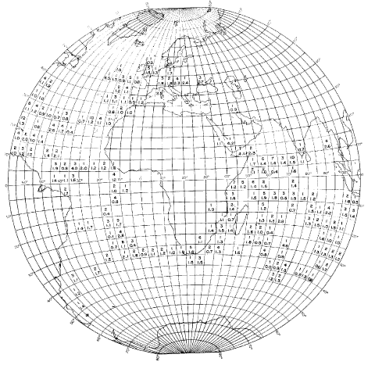Several research studies aim to map the data of the global heat-flow database. Here, we compile the published paper known to us.

Lucazeau (2019)
Lucazeau, F. (2019). Analysis and Mapping of an Updated Terrestrial Heat Flow Data Set. Geochemistry, Geophysics, Geosystems, 20(8), 4001-4024. doi:10.1029/2019gc008389
Mapping: generalized similarity method, global 0.5° × 0.5° grid
Google Earth file of global heat-flow interpolation - Lucazeau (2019)

Mareschal et al. (2017)
Mareschal, J.-C., Jaupart, C., Iarotsky, L. (2017). The Earth Heat Budget, Crustal Radio-activity and Mantle Geoneutrinos. In L. Ludhova (Ed.), Neutrino Geoscience (pp. 4.1-4.46): Open Academic Press.
Mapping: interpolation between continental heat flow data points; in the oceans it uses a plate cooling model to predict the heat flow as a function of sea floor age.

Davies (2013)
Mapping: A global map of surface heat flow is presented on a 2° x 2° equal area grid. It is based on a global heat flow data set of over 38,000 measurements. The map consists of three components. First, in regions of young ocean crust (younger 67.7 Ma) the model estimate uses a half-space conduction model based on the age of the oceanic crust, since it is well known that raw data measurements are frequently influenced by significant hydrothermal circulation. Second, in other regions of data coverage the estimate is based on data measurements. At the map resolution, these two categories (young ocean, data covered) cover 65% of Earth’s surface. Third, for all other regions the estimate is based on the assumption that there is a correlation between heat flow and geology.

Goutorbe et al. (2011)
Goutorbe, B., Poort, J., Lucazeau, F., Raillard, S. (2011). Global heat flow trends resolved from multiple geological and geophysical proxies. Geophysical Journal International, 187(3), 1405-1419. doi:10.1111/j.1365-246X.2011.05228.x
Mapping: Integrates multiple proxies derived from a large body of global geological and geophysical data sets. Two simple empirical methods are used: both of them are based on a set of examples, where heat flow measurements are associated with relevant terrestrial observables such as surface heat production, upper-mantle velocity structure, tectono-thermal age, on a 1°× 1° grid. To a given target point owning a number of observables, the methods associate a heat flow distribution rather than a deterministic value to account for intrinsic variability and uncertainty within a defined geodynamic environment. The ‘best combination method’ seeks the particular combination of observables that minimizes the dispersion of the heat flow distribution generated from the set of examples. The ‘similarity method’ attributes a weight to each example depending on its degree of similarity with the target point.

Davies & Davies (2010)
Davies, J. H., Davies, D. R. (2010). Earth's surface heat flux. Solid Earth, 1(1), 5-24. doi:10.5194/se-1-5-2010
Mapping: oceanic: accounts for hydrothermal circulation in young oceanic crust by utilising a half-space cooling approximation. Continental: estimate the average heat flow for different geologic domains as defined by global digital geology maps; and then produce the global estimate by multiplying it by the total global area of that geologic domain. The averaging is done on a polygon set which results from an intersection of a 1° equal area grid with the original geology polygons





